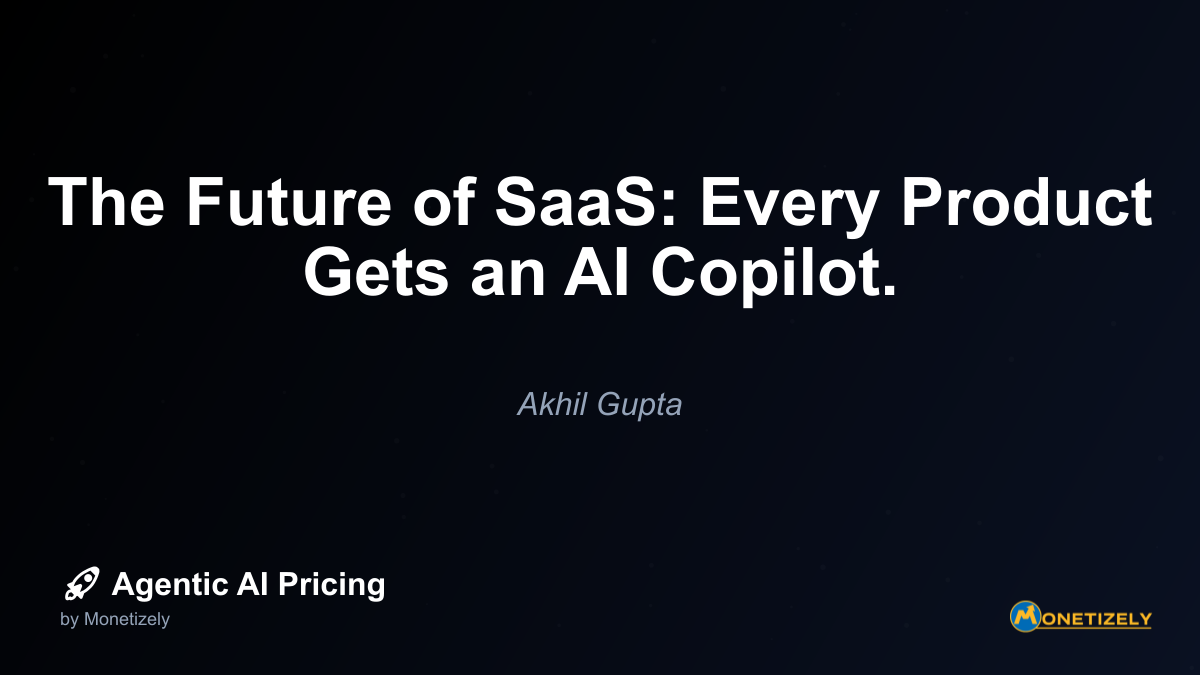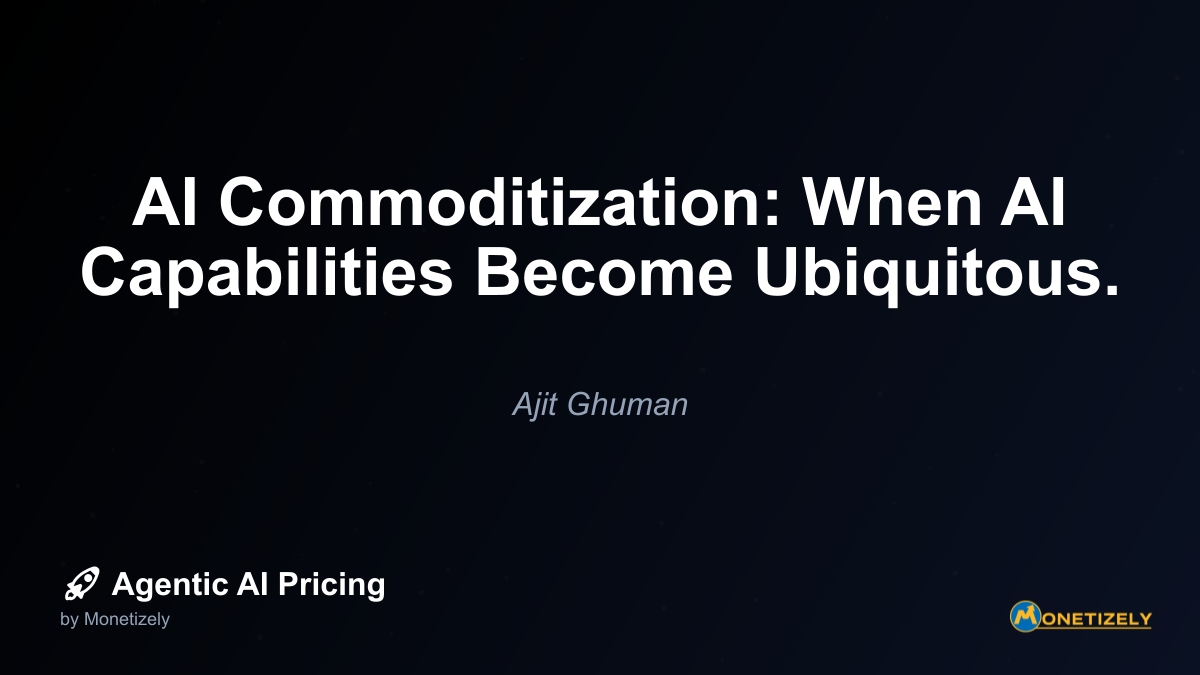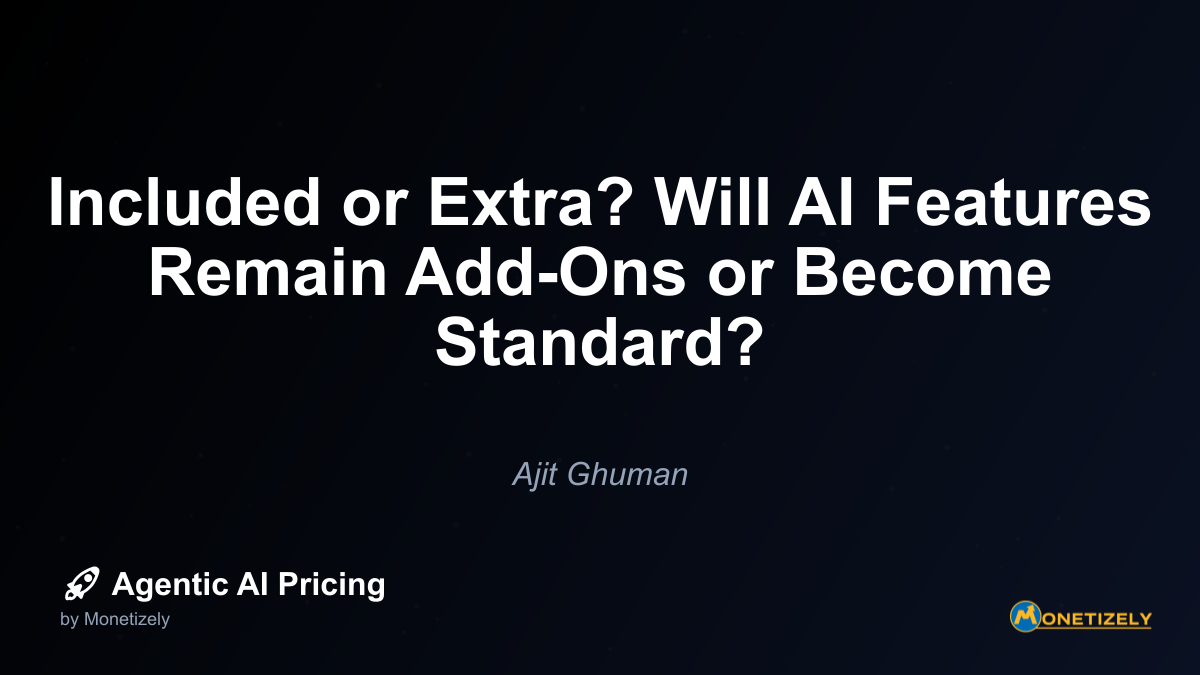· Akhil Gupta · Emerging Trends · 10 min read
The Future of SaaS: Every Product Gets an AI Copilot.
AI and SaaS Pricing Masterclass
Learn the art of strategic pricing directly from industry experts. Our comprehensive course provides frameworks and methodologies for optimizing your pricing strategy in the evolving AI landscape. Earn a professional certification that can be imported directly to your LinkedIn profile.

The Evolution of AI Pricing Models: From Early Adopters to Mainstream
The current landscape of AI copilot pricing reflects the classic pattern of new technology adoption. Early in a technology’s lifecycle, premium pricing models dominate as companies seek to recoup R&D investments while serving early adopters willing to pay for cutting-edge capabilities.
As Microsoft’s Copilot pricing strategy reveals about the future of AI monetization, we’re witnessing a significant inflection point. The initial premium pricing approach ($30/user/month) signals Microsoft’s confidence in the value proposition while allowing them to manage the scaling challenges of this resource-intensive technology.
However, historical technology adoption patterns suggest this premium positioning is likely temporary. Consider these parallel examples from technology history:
- Web Browsers: Initially sold as standalone products before becoming free and ubiquitous.
- Email Services: Once premium offerings that evolved into standard expectations.
- Cloud Storage: Transitioned from premium add-ons to included baseline allocations.
- Mobile Apps: Many categories shifted from paid to freemium or ad-supported.
The transition typically follows a predictable pattern:
- Premium Phase: Early versions command premium prices from innovators and early adopters.
- Competitive Disruption: A competitor includes the technology in their base offering to gain market share.
- Feature Parity Race: Industry-wide inclusion of the technology as a standard feature.
- New Premium Tier: Advanced versions of the technology emerge as the new premium offering.
This pattern suggests AI copilots will likely follow a similar trajectory, with basic AI assistance becoming standard while advanced, specialized capabilities continue commanding premium prices.
Market Segmentation: Different Approaches for Different Sectors
The monetization approach for AI copilots varies significantly across market segments, reflecting differences in value perception, competitive dynamics, and cost structures:
Enterprise Software
Enterprise software vendors like Microsoft, Salesforce, and SAP have largely adopted premium pricing models for AI capabilities. This approach makes sense given:
- Enterprise customers typically evaluate ROI rigorously and can justify premium pricing based on productivity gains.
- The complexity of enterprise workflows creates opportunities for highly differentiated AI assistance.
- Enterprise data security and compliance requirements necessitate sophisticated AI implementations.
SMB-Focused Solutions
Software targeting small and medium businesses shows more variation in AI pricing approaches:
- Some vendors bundle AI capabilities to differentiate in competitive markets.
- Others offer tiered AI functionality, with basic capabilities included and advanced features premium-priced.
- Usage-based models are emerging to align costs with actual value delivery.
Consumer Applications
Consumer-facing applications have generally leaned toward bundled AI capabilities:
- Competitive pressure in consumer markets drives inclusion of AI features in base offerings.
- Consumer willingness to pay explicitly for AI capabilities remains limited.
- Ad-supported models enable “free” AI capabilities subsidized by advertising revenue.
Cost Considerations: The Economics of AI Integration
The economics of AI copilot implementation significantly impact pricing decisions. Key cost components include:
1. Model Licensing and API Costs
Many SaaS companies leverage foundation models from providers like OpenAI, Anthropic, or Google, incurring per-token or per-query costs. These variable costs create margin pressure when AI features are heavily used, potentially making unlimited usage in base offerings economically challenging.
2. Computational Infrastructure
AI inference requires substantial computational resources. While costs continue to decline, they remain significant, especially for real-time applications requiring low-latency responses.
3. Training and Fine-tuning
Creating domain-specific AI capabilities often requires custom fine-tuning, which demands specialized expertise and computational resources.
4. Data Management and Security
Ensuring data privacy, implementing proper controls, and maintaining secure infrastructure add significant overhead to AI implementations.
5. Ongoing Improvement
AI systems require continuous monitoring, evaluation, and improvement to maintain quality and address emerging edge cases.
These cost factors suggest that while basic AI capabilities may eventually become standardized, advanced features with high computational requirements will likely remain premium-priced to ensure sustainable economics.
The Productivity Paradox: Value Perception vs. Value Capture
The fundamental challenge in AI copilot pricing stems from what economists call the productivity paradox—the gap between the value created and the ability to capture that value through pricing.
AI assistants can deliver remarkable productivity gains. Microsoft claims its Copilot increases productivity by 29% on average across common work tasks. Similar productivity claims come from GitHub, Notion, and other AI-enhanced platforms.
However, several factors complicate value capture:
Value Attribution: Users may struggle to attribute productivity gains specifically to the AI assistant versus other improvements.
Expectation Inflation: As AI capabilities become more common, user expectations shift, making it harder to maintain premium pricing for capabilities increasingly viewed as standard.
Competitive Pressure: In competitive markets, the ability to charge premiums for AI features diminishes as competitors include similar capabilities.
Indirect Value Creation: Many AI benefits accrue indirectly (improved user satisfaction, reduced churn) rather than through direct productivity measures.
This suggests companies should consider multi-dimensional value capture approaches beyond direct premium pricing, such as:
- Using AI capabilities to reduce customer acquisition costs through improved trial conversion
- Leveraging AI to increase retention and lifetime value
- Employing AI to enable expansion into adjacent market segments
- Utilizing AI to reduce support costs while improving user satisfaction
Strategic Considerations for SaaS Leaders
As SaaS executives formulate their AI copilot strategies, several critical considerations should guide decision-making:
1. Competitive Positioning Analysis
Assess where your product stands in the competitive landscape:
- Are you a market leader who can establish premium pricing norms?
- Are you challenging an incumbent where bundled AI could create competitive advantage?
- Is your market experiencing rapid AI feature proliferation requiring immediate response?
2. Customer Value Alignment
Evaluate how AI capabilities align with your customers’ value perception:
- Is AI solving a critical pain point worth explicit premium pricing?
- Does AI enhance core product functionality in ways customers already expect?
- Can you clearly articulate and demonstrate the ROI of AI capabilities?
3. Cost Structure Assessment
Analyze your cost structure to determine sustainable pricing approaches:
- What are your per-user AI infrastructure and API costs?
- How do usage patterns affect your unit economics?
- Can you implement usage limits or tiering to manage costs while delivering value?
4. Long-term Strategic Vision
Consider how AI fits into your long-term product and business strategy:
- Is AI a transformative capability central to your future value proposition?
- Are you using AI primarily as a competitive response?
- Does AI enable new business models or market opportunities beyond current offerings?
Implementation Approaches: Beyond the Binary Choice
While the premium add-on versus bundled inclusion dichotomy frames the core decision, several nuanced approaches have emerged:
1. Tiered AI Capabilities
Many companies are implementing tiered approaches where basic AI capabilities are included in standard offerings while advanced features command premium prices:
- Basic Tier: Simple automations, suggestions, and assistance included in base pricing
- Advanced Tier: More sophisticated capabilities, customization options, and higher usage limits at premium prices
- Enterprise Tier: Custom model training, advanced security, and integration capabilities at highest price points
2. Usage-Based Limitations
Some companies include AI capabilities in base offerings but with usage limitations:
- Query Quotas: Limited number of AI interactions included, with overages billed separately
- Complexity Tiers: Simple queries included, complex operations premium-priced
- Time-Based Limits: Basic response times included, priority processing premium-priced
3. Feature-Based Segmentation
Another approach segments specific AI capabilities across pricing tiers:
- Document Analysis: Basic document processing included, advanced analysis premium-priced
- Creative Generation: Simple content suggestions included, full content generation premium-priced
- Workflow Automation: Manual process assistance included, full automation premium-priced
4. Time-Limited Strategies
Some companies are employing time-based approaches to manage the transition:
- Extended Free Trials: Offering extended access to AI features before implementing premium pricing
- Introductory Pricing: Starting with lower premium prices that increase as capabilities mature
- Grandfather Provisions: Including AI capabilities for existing customers while premium-pricing for new customers
Case Studies: Learning from Market Leaders
Examining how market leaders are approaching AI copilot pricing provides valuable insights:
Microsoft: The Premium Path
Microsoft’s approach with its Microsoft 365 Copilot exemplifies the premium add-on strategy. Priced at $30 per user per month (a 60% premium over the standard Microsoft 365 E3 license), Microsoft is positioning Copilot as a transformative productivity enhancer worth significant investment.
Key aspects of Microsoft’s strategy include:
- Clear ROI messaging focused on productivity gains and time savings
- Phased enterprise rollout to manage scaling and gather success stories
- Integration across the entire productivity suite to maximize value perception
- Continued investment in new capabilities to maintain premium justification
This approach allows Microsoft to manage the substantial infrastructure costs while establishing AI assistance as a premium capability worth explicit investment.
Notion: The Bundled Approach
Notion took a different path by including its AI assistant in its standard paid plans without additional charges. This approach:
- Accelerated adoption and usage, generating valuable training data
- Created competitive differentiation against other knowledge management platforms
- Established Notion as an AI-forward platform attractive to innovative teams
- Used AI as a conversion driver from free to paid plans
Notion’s strategy recognizes that in the competitive knowledge management space, AI capabilities serve as a powerful differentiator and conversion catalyst.
GitHub: The Hybrid Model
GitHub’s approach with Copilot represents a hybrid model. The company offers:
- Individual developers a standalone subscription ($10/month)
- Business customers organization-wide licensing ($19/user/month)
- Integration with GitHub Enterprise at the highest tier
This tiered approach allows GitHub to capture value proportional to usage intensity while encouraging widespread adoption.
The Path Forward: From Premium to Pervasive
Based on historical technology adoption patterns and current market dynamics, we can project a likely evolution path for AI copilot pricing:
Phase 1: Premium Differentiation (2023-2024)
In this current phase, AI capabilities command premium prices as companies recoup R&D investments and early adopters willingly pay for cutting-edge functionality.
Phase 2: Competitive Inclusion (2024-2025)
As competition intensifies, more companies will include basic AI capabilities in standard offerings to maintain competitive parity, while premium tiers will feature advanced AI functionality.
Phase 3: Baseline Expectation (2025-2027)
Basic AI assistance will become an expected component of software products, with differentiation occurring through the sophistication, accuracy, and domain-specificity of AI capabilities.
Phase 4: New Premium Frontier (2027+)
Advanced AI capabilities—perhaps multi-agent systems, personalized models, or specialized domain expertise—will emerge as the new premium tier, while yesterday’s advanced features become today’s standard offering.
Strategic Recommendations for SaaS Leaders
As you navigate this rapidly evolving landscape, consider these strategic recommendations:
1. Adopt a Staged Approach
Rather than viewing the premium vs. bundled decision as binary, consider a staged approach:
- Begin with premium positioning to manage costs and establish value
- Gradually incorporate basic capabilities into standard offerings as costs decrease
- Maintain premium tiers for advanced capabilities with clear ROI
2. Focus on Differentiated Value
Generic AI capabilities will commoditize quickly. Focus on domain-specific AI that delivers unique value:
- Invest in domain-specific training data and model fine-tuning
- Build AI that leverages your unique data advantages
- Create AI capabilities that complement your core value proposition
3. Align with Customer Workflows
The most valuable AI capabilities integrate seamlessly into existing workflows rather than requiring behavior change:
- Map the customer journey to identify high-friction touchpoints
- Target AI assistance at moments of maximum cognitive load
- Design for progressive disclosure of AI capabilities
4. Build Flexibility into Pricing Models
Given the rapid evolution of AI technology and economics, build flexibility into your pricing approach:
- Design systems that can support usage-based components
- Create clear upgrade paths as capabilities evolve
- Establish metrics to trigger pricing model reassessment
5. Communicate Value, Not Technology
Frame your pricing narrative around value delivery rather than technological capabilities:
- Quantify productivity gains in customer-relevant terms
- Showcase specific use cases with measurable outcomes
- Develop ROI calculators that translate AI capabilities into business value
Conclusion: Navigating the Inevitable Transition
The question isn’t whether AI copilots will become standard features in SaaS products—they will. The real strategic questions concern timing, positioning, and value capture during the transition.
SaaS leaders who approach this transition strategically will find opportunities to create competitive advantage while establishing sustainable economics. Those who wait too long risk being caught in a reactive position as market expectations shift.
The most successful companies will likely employ hybrid approaches that evolve with the market—starting with premium positioning for differentiated AI capabilities while gradually incorporating basic AI assistance into standard offerings. Throughout this evolution, the focus must remain on delivering measurable value that aligns with customer needs rather than technology for its own sake.
As AI copilots transform from luxury to necessity, the winners will be those who master not just the technology itself, but the art of evolving their value proposition and pricing strategy in harmony with changing market dynamics.
Co-Founder & COO
Akhil is an Engineering leader with over 16+ years of experience in building, managing and scaling web-scale, high throughput enterprise applications and teams. He has worked with and led technology teams at FabAlley, BuildSupply and Healthians. He is a graduate from Delhi College of Engineering and UC Berkeley certified CTO.
Pricing Strategy Audit
Let our experts analyze your current pricing strategy and identify opportunities for improvement. Our data-driven assessment will help you unlock untapped revenue potential and optimize your AI pricing approach.




